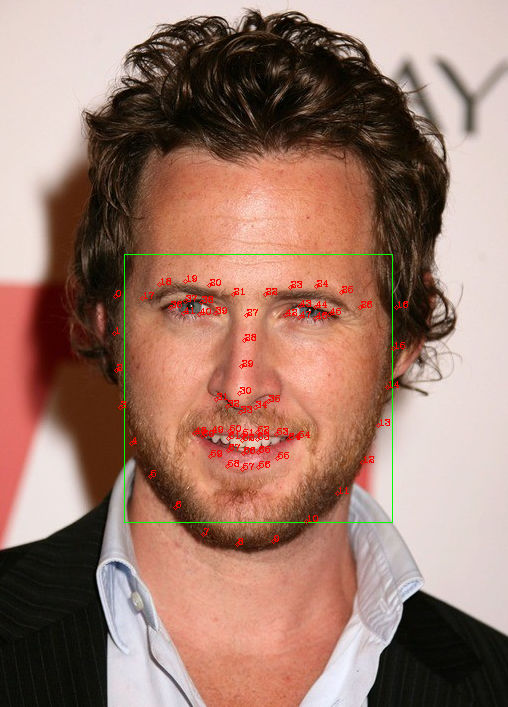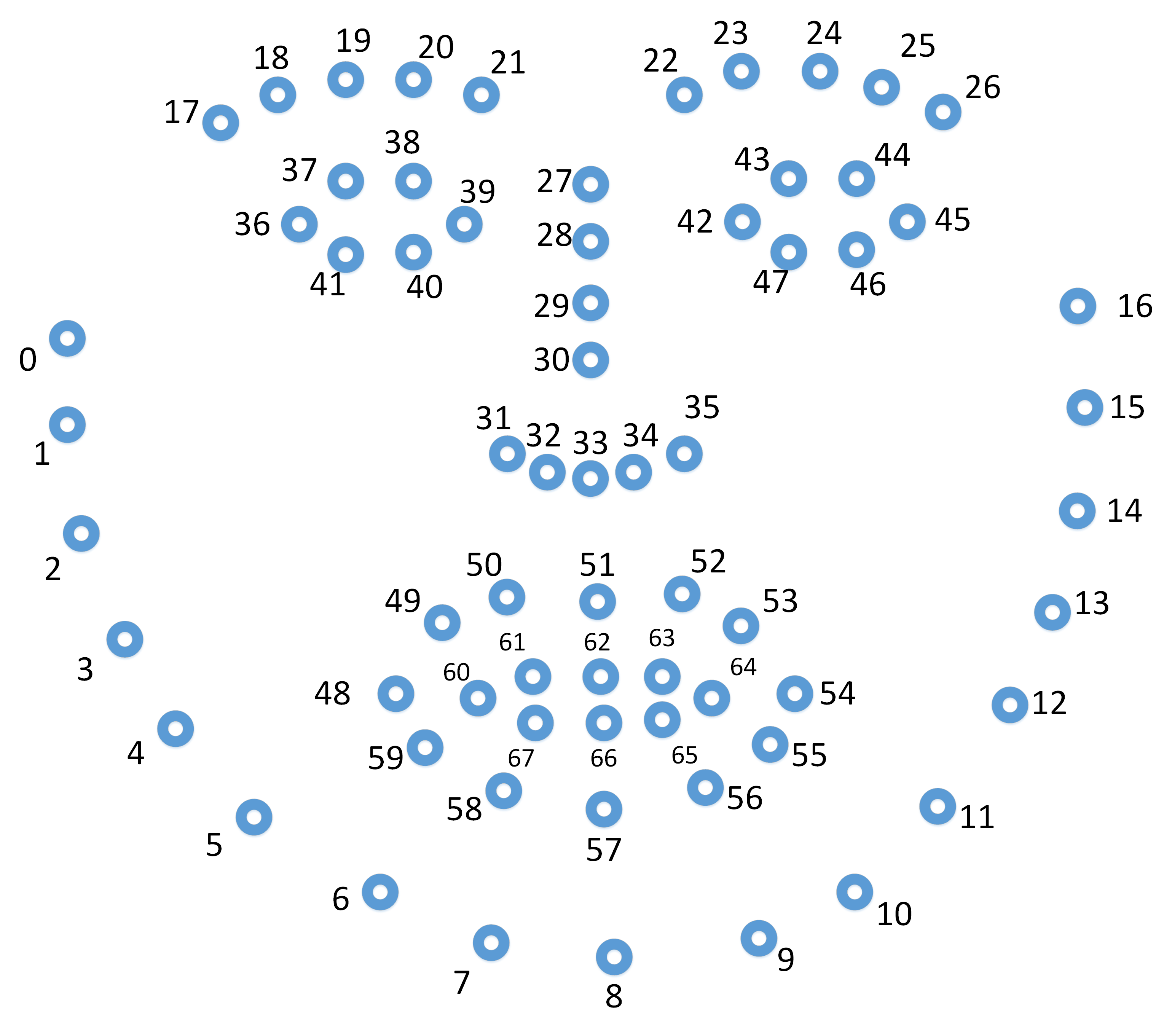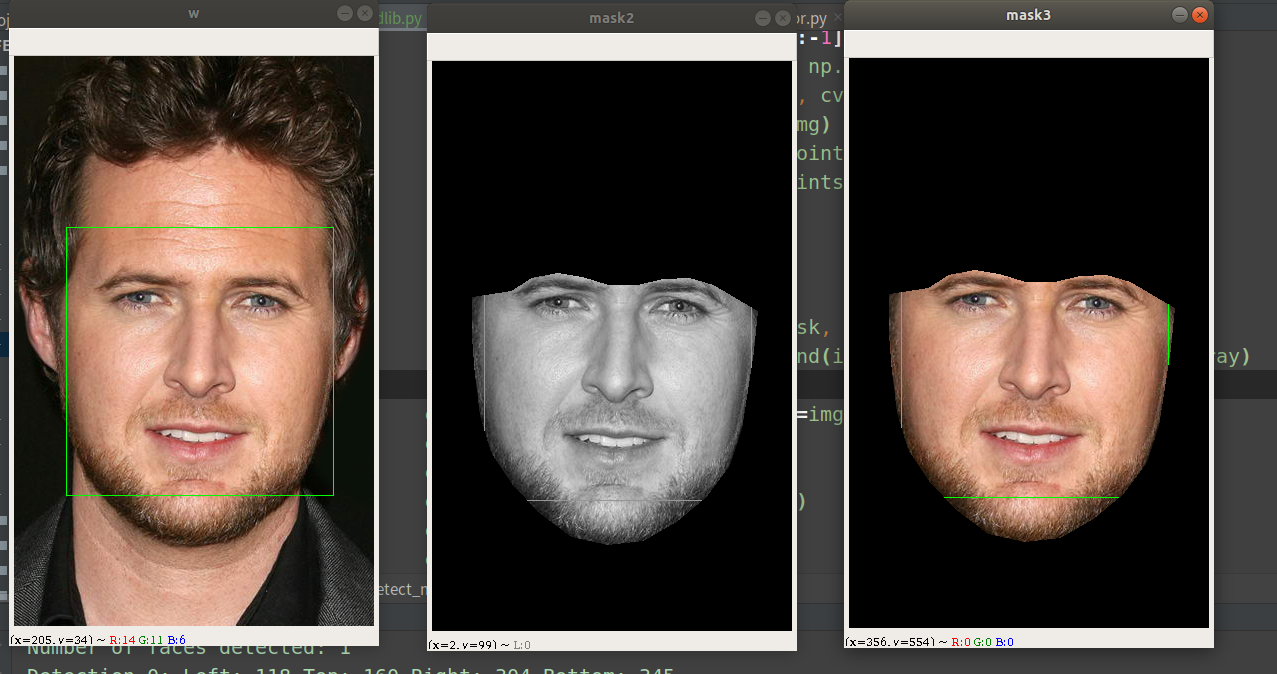#!/usr/bin/env python
# -*- coding:utf-8-*-
# file: {NAME}.py
# @author: jory.d
# @contact: dangxusheng163@163.com
# @time: 2020/04/10 19:42
# @desc: 使用dlib进行人脸检测和人脸关键点
import cv2
import numpy as np
import glob
import dlib
FACE_DETECT_PATH = "/home/build/dlib-v19.18/data/mmod_human_face_detector.dat"
FACE_LANDMAKR_5_PATH = "/home/build/dlib-v19.18/data/shape_predictor_5_face_landmarks.dat"
FACE_LANDMAKR_68_PATH = "/home/build/dlib-v19.18/data/shape_predictor_68_face_landmarks.dat"
def face_detect():
root = "/media/dangxs/E/Project/DataSet/VGG Face Dataset/vgg_face_dataset/vgg_face_dataset/vgg_face_dataset"
imgs = glob.glob(root + "/**/*.jpg", recursive=True)
assert len(imgs) > 0
detector = dlib.get_frontal_face_detector()
predictor = dlib.shape_predictor(FACE_LANDMAKR_68_PATH)
for f in imgs:
img = cv2.imread(f)
# The 1 in the second argument indicates that we should upsample the image
# 1 time. This will make everything bigger and allow us to detect more
# faces.
dets = detector(img, 1)
print("Number of faces detected: {}".format(len(dets)))
for i, d in enumerate(dets):
x1, y1, x2, y2 = d.left(), d.top(), d.right(), d.bottom()
print("Detection {}: Left: {} Top: {} Right: {} Bottom: {}".format(
i, x1, y1, x2, y2))
cv2.rectangle(img, (x1, y1), (x2, y2), (0, 255, 0), 1)
# Get the landmarks/parts for the face in box d.
shape = predictor(img, d)
print("Part 0: {}, Part 1: {} ...".format(shape.part(0), shape.part(1)))
# # Draw the face landmarks on the screen.
"""
# landmark 顺序: 外轮廓 - 左眉毛 - 右眉毛 - 鼻子 - 左眼 - 右眼 - 嘴巴
"""
for i in range(shape.num_parts):
x, y = shape.part(i).x, shape.part(i).y
cv2.circle(img, (x, y), 2, (0, 0, 255), 1)
cv2.putText(img, str(i), (x, y), cv2.FONT_HERSHEY_COMPLEX, 0.3, (0, 0, 255), 1)
cv2.resize(img, dsize=None, dst=img, fx=2, fy=2)
cv2.imshow("w", img)
cv2.waitKey(0)
def face_detect_mask():
root = "/media/dangxs/E/Project/DataSet/VGG Face Dataset/vgg_face_dataset/vgg_face_dataset/vgg_face_dataset"
imgs = glob.glob(root + "/**/*.jpg", recursive=True)
assert len(imgs) > 0
detector = dlib.get_frontal_face_detector()
predictor = dlib.shape_predictor(FACE_LANDMAKR_68_PATH)
for f in imgs:
img = cv2.imread(f)
# The 1 in the second argument indicates that we should upsample the image
# 1 time. This will make everything bigger and allow us to detect more
# faces.
dets = detector(img, 1)
print("Number of faces detected: {}".format(len(dets)))
for i, d in enumerate(dets):
x1, y1, x2, y2 = d.left(), d.top(), d.right(), d.bottom()
print("Detection {}: Left: {} Top: {} Right: {} Bottom: {}".format(
i, x1, y1, x2, y2))
cv2.rectangle(img, (x1, y1), (x2, y2), (0, 255, 0), 1)
# Get the landmarks/parts for the face in box d.
shape = predictor(img, d)
print("Part 0: {}, Part 1: {} ...".format(shape.part(0), shape.part(1)))
# # Draw the face landmarks on the screen.
"""
# landmark 顺序: 外轮廓 - 左眉毛 - 右眉毛 - 鼻子 - 左眼 - 右眼 - 嘴巴
"""
points = []
for i in range(shape.num_parts):
x, y = shape.part(i).x, shape.part(i).y
if i < 26:
points.append([x, y])
# cv2.circle(img, (x, y), 2, (0, 0, 255), 1)
# cv2.putText(img, str(i), (x,y),cv2.FONT_HERSHEY_COMPLEX, 0.3 ,(0,0,255),1)
# 只把脸切出来
points[17:] = points[17:][::-1]
points = np.asarray(points, np.int32).reshape(-1, 1, 2)
img_gray = cv2.cvtColor(img, cv2.COLOR_BGR2GRAY)
black_img = np.zeros_like(img)
cv2.polylines(black_img, [points], 1, 255)
cv2.fillPoly(black_img, [points], (1, 1, 1))
mask = black_img
masked_bgr = img * mask
# 位运算时需要转化成灰度图像
mask_gray = cv2.cvtColor(mask, cv2.COLOR_BGR2GRAY)
masked_gray = cv2.bitwise_and(img_gray, img_gray, mask=mask_gray)
cv2.resize(img, dsize=None, dst=img, fx=2, fy=2)
cv2.imshow("w", img)
cv2.imshow("mask", mask)
cv2.imshow("mask2", masked_gray)
cv2.imshow("mask3", masked_bgr)
cv2.waitKey(0)
if __name__ == "__main__":
face_detect()



以上就是python使用dlib进行人脸检测和关键点的示例的详细内容,更多关于python 人脸检测的资料请关注服务器之家其它相关文章!
原文链接:https://www.cnblogs.com/dxscode/p/12676293.html










